Lifting the curtain on Maribor: European Capital of Culture 2012
Maribor takes to the stage this year as UNESCO’s European Capital of Culture, offering a plethora of artistic activities and enlivening entertainment. Jonny Payne travelled to Slovenia’s second city to see just what all the fuss is about.
I stand on the corner of Poštna Street (Poštna ulica) in central Maribor anxiously waiting for my turn in the booth. Beside me a red light flashes while funky beats permeate the balmy night-time air. When it’s finally my turn, I step inside and am instantly greeted by Sabina, a woman in her early forties with seductive eyes. Suddenly the door to the outside world is closed by a scary-looking man dressed from head to toe in black. “Fifteen minutes”, he says gruffly.
Sabina sits opposite me in the booth, which is an old cable car from the nearby Mariborsko Pohorje ski resort, and tells me a bit about herself. She’s a part-time artist and poet and just one of a number of ‘intellectual whores’ operating on the corner of Poštna Street.
Intellectual Whores is an original street performance concept whereby customers pay for a lady’s intellectual services – the idea being the lady initiates the conversation with her client in the realms of politics, economics or the arts. According to organisers, the aim of the project is to highlight the “underuse of the intellectual potential of the Slovenian female”. After a discussion about poetry, Sabina tells me to pick a card from a pack of her own poems and translates it for me. It’s beautiful and focuses on springtime.
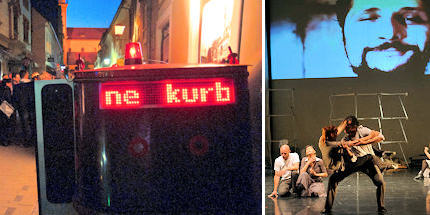 Intellectual Whores / Travelogue 2
Intellectual Whores / Travelogue 2Maribor 2012 ECOC Miha Sagadin / LukaCajnkar
This is just one of 1,000 or so cultural events taking place across Maribor as it celebrates its year as UNESCO’s European Capital of Culture. In fact, Maribor is just one of six towns and cities encompassing the European capital of Culture tag in Slovenia (the others being Ptuj, Murska Sobota, Slovenj Gradec, Novo Mesto and Velenje), but it’s the biggest and the most happening.
Part of the effort has been to renovate and reinvigorate old buildings into new cultural venues and exhibition spaces. Add these ‘new’ spaces to the grand Slovenian National Theatre Maribor, a puppet theatre and existing art galleries, and the city has an impressive array of cultural offerings.
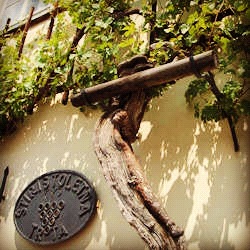 Learn about the oldest wine-producing vine in the world
Learn about the oldest wine-producing vine in the worldWTG / Jonny Payne
After my 15 minutes with Sabina is up, I leave, having had my brain cells tantalised, and skulk off into the night, which is alive with the sounds of street performers, crowded bars and pumping clubs.
As I pass the aptly named After Work Stage, which is hosting a live funk duo; skirt the rather more calming Ethno Stage in Jewish Square (Židovski trg) – just two of eight open-air stages throughout the city – and head towards Leon Štukelj Square (Leona Štukelj trg), where a skate festival is starting to wind down, it’s evident Maribor is determined not to let its year in the spotlight pass it by.
It’s not just the organised events that are contributing to the feel-good atmosphere. For example, I stop off at a small art gallery where the pavement outside has been painted with hundreds of flowers, and am handed a paint brush to make my own pitiful contribution that looks more like a starfish than a pretty bloom.
During my time in this compact city I see Travelogue 2, a contemporary dance performance expertly executed by a Turkish dance troupe; Mini Circus Buffetto, a fascinating clown performance – the type of entertainment that has sadly disappeared in much of Western Europe – and visit a surprisingly fascinating exhibition featuring thousands of toy tin soldiers.
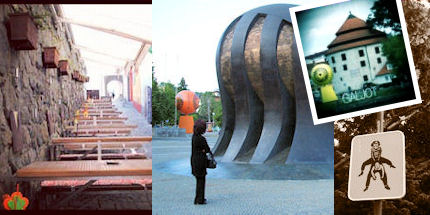 Explore Maribor's culture in its narrow streets and expansive squares
Explore Maribor's culture in its narrow streets and expansive squaresWTG / Jonny Payne
As befits a university town, the student population leads much of the late-night revelry, and during my time here the students are out in force, enjoying the many bar-lined streets. I’m told the city is quieter at weekends when many students head home to their families in other parts of Slovenia, but there is little evidence of the mass departure on this occasion, and who can blame them for staying?
The locals are used to this cultural immersion, as every June the city celebrates the Lent Festival, a two-week extravaganza celebrating all aspects of the arts, including music, comedy and theatre. Lent is the oldest part of the city, where culture thrives in the narrow streets that fringe the Drava River. From here, verdant hills of grapevines can be seen engulfing the city and visitors can discover the world’s oldest wine-producing vine – the product of which is so exclusive, it’s only ever given to high-ranking dignitaries.
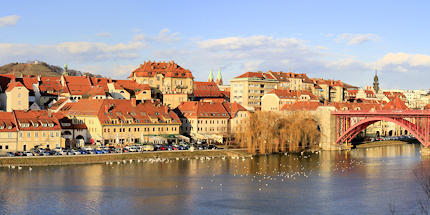 Visit Lent, where the annual cultural festival takes place
Visit Lent, where the annual cultural festival takes placeMaribor Tourist Office / Karmen Razlag
The city’s squares are the epicentre of everyday life here, and none more so than Castle Square (Grajski trg), which this weekend is filled with sixty-somethings promenading around looking for a hot date, just as they did forty years ago. The square offers numerous cafés and restaurants, reminiscent of expansive squares in Vienna and Prague and is the perfect place to indulge in a spot of people-watching.
The nearby Leon Štukelj Square (Leona Štukelj trg), which is home to a bar serving ‘green beer’ (I’m told it’s green, although I’m a little too unnerved to pluck up the courage to order one), is today a venue for local youths practicing acrobatics that can only be described as trampolining on a tightrope. Meanwhile, Slomškov Square (Slomškov trg) – which is flanked by the pistachio ice cream-coloured post office, the gothic cathedral and the Slovenian National Theatre Maribor – is peppered with dog walkers, bookworms and young families. All this under the watchful bronzed gaze of beatified Slovenian bishop Anton Martin Slomšek.
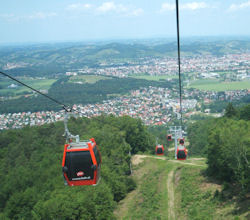 Catch sweeping views of the city from Pohorje
Catch sweeping views of the city from PohorjeWTG / Jonny Payne
For a good view of the Old Town’s red-tiled roofs, take a boat ride along the Drava River, where this year you’ll also see man-sized white letters plucked from literary works by acclaimed Slovenian poet Drago Jančar. For more expansive views of the city, however, head high up into the hills to Pohorje. This area is home to Slovenia's largest ski resort in winter and an adrenaline-fuelled retreat in summer, where mountain biking and hiking are popular activities throughout the warmer months.
But this year its the city’s culture that's undoubtedly the main draw. Maribor is not shy in the limelight, and fortunately so, as next year it will become European Youth Capital. Luckily therefore, the curtain on this charming city’s festivities sees no sign of coming down just yet.
Need to know:
Where to stay: Hotel City Maribor. Prices from €110. Find deals for Hotel City Maribor with World Travel Guide.
Where to eat: Rožmarin, seasonal specialities using local ingredients. Opt for the €29 four-course set menu.
Where to party: The various lively bars and clubs in Poštna Street and the narrow Mesarski Prehod alleyway off Glavni Square (Glavni trg).
For more information visit: www.visitmaribor.si or www.slovenia.info
Do you have any Feedback about this page?
© 2025 Columbus Travel Media Ltd. All rights reserved. No part of this site may be reproduced without our written permission, click here for information on Columbus Content Solutions.









 You know where
You know where